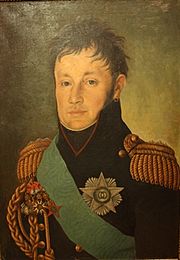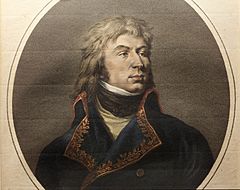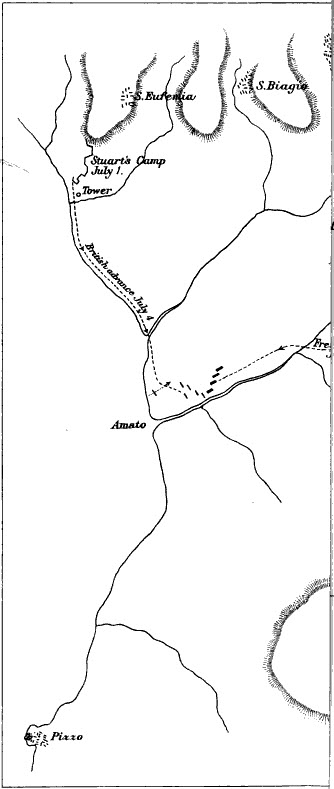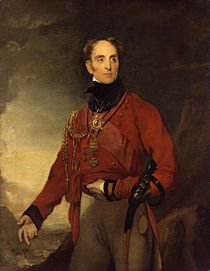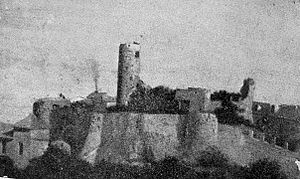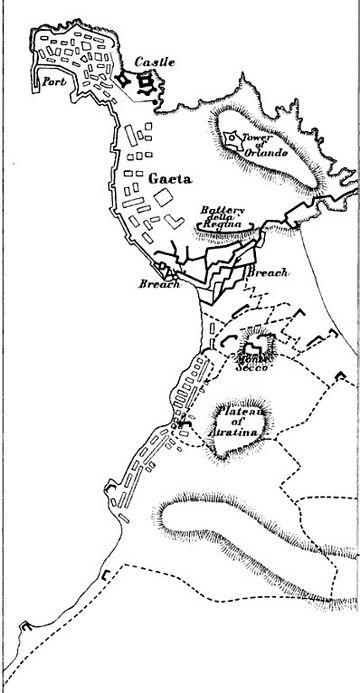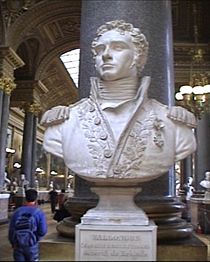Invasion of Naples (1806) facts for kids
Quick facts for kids Invasion of Naples (1806) |
|||||||
|---|---|---|---|---|---|---|---|
| Part of the War of the Third Coalition | |||||||
 Battle of Maida, by Philip James de Loutherbourg |
|||||||
|
|||||||
| Belligerents | |||||||
| Commanders and leaders | |||||||
| Strength | |||||||
| 41,000 | Naples: 22,000 United Kingdom: 5,200 Russia: 6,000 Total: 33,200 |
||||||
The Invasion of Naples was a big military event in 1806. It was part of the War of the Third Coalition. An army from the French Empire, led by Marshal André Masséna, marched from northern Italy into the Kingdom of Naples. Naples was an ally of the countries fighting against France, and its ruler was King Ferdinand IV.
The Neapolitan army was quickly defeated at Campo Tenese. The French invasion was mostly successful. However, there were some tough challenges. These included a long Siege of Gaeta, a British victory at the Battle of Maida, and a fierce fight by local people against the French.
The French didn't get full control because King Ferdinand escaped to Sicily. He was protected there by the Royal Navy and a British army. In 1806, Emperor Napoleon made his brother, Joseph Bonaparte, the new king of southern Italy.
The main reason for the invasion was that King Ferdinand broke his promise to Napoleon. Napoleon and Ferdinand had signed an agreement. It said the French would leave a part of Italy called Apulia. In return, the Kingdom of Naples would stay neutral in the upcoming War of the Third Coalition. But as soon as the French left, Ferdinand let British and Russian armies into his kingdom.
In December 1805, Napoleon's armies crushed the armies of Austria and Russia. When the Russian troops in Naples were called back home, the British also left. This left Ferdinand's kingdom open to French attack.
Contents
Why the Invasion Happened
Setting the Stage for Conflict
To protect his lands in northern Italy, Emperor Napoleon had many soldiers there in early 1805. His main army had 68,000 men. The nearby Kingdom of Italy added 8,000 soldiers. Another 18,000 watched the border of the Kingdom of Naples.
In 1802, the Treaty of Amiens was signed. It said that Britain had to leave the island of Malta. France also had to leave the part of the Kingdom of Naples it occupied. But British leaders soon changed their minds and refused to give up Malta. So, the French army kept control of Apulia, a region in southern Italy with important ports like Taranto.
King Ferdinand IV of Naples had only about 22,000 soldiers. He was worried that the French army might invade his kingdom. So, he made a deal with Napoleon to stay neutral during the War of the Third Coalition. This agreement was signed on September 21, 1805. It said that Naples would send away all foreign officers from its army. It also promised not to let any foreign troops land in its territory. In return, the French agreed to leave Apulia.
British and Russian Troops Arrive
As soon as the French army left Apulia, King Ferdinand and Queen Maria Carolina broke their promise. They invited two armies from the countries fighting France to come to Naples. Lieutenant General James Henry Craig sailed from Malta with 7,500 British soldiers. General Maurice Lacy led 14,500 Russian troops from Corfu. These British and Russian forces landed in Naples on November 20, 1805.
The Neapolitan army was not well-organized. It could not help with any attacks. So, the British and Russian generals decided to stay on defense. They placed their troops at the border. The British were behind the Garigliano River. The Russians were on their right in the mountains. A small Neapolitan force was on the Adriatic coast. The Kingdom of Naples tried to get more people to join the army, but military service was not popular. The army only grew by 6,000 men.
Napoleon's big victory at the Battle of Austerlitz in December 1805 ended the Third Coalition. The Russian leader, Czar Alexander, ordered his troops to leave Naples. When the British general heard this, he decided to pull his troops out too. This made the Neapolitan government panic. They knew they would soon face the French alone, after breaking their promise to Napoleon.
The Russian general offered to take a defensive position in Calabria, the "toe" of Italy. But the royal court refused. Insulted, the Russian general left Naples. The British general offered to defend the fortress of Gaeta. But its governor, Prince Louis of Hesse-Philippsthal, would not let his men in. The British general then sailed to Messina in Sicily. His men waited on their ships until the king and queen finally allowed them to land on February 13, 1806.
The French Army of Naples
In January 1806, the French army watching Naples was renamed the Army of Naples. It was officially led by Joseph Bonaparte, Napoleon's brother. But André Masséna was the real military commander. Napoleon wanted Joseph to be the king of Naples.
The army was split into three parts. One part was at Rome, another at Ancona, and a third was marching from Austria. In total, Masséna's army would have more than 41,000 men. Even though the army was good at fighting, it had problems. The soldiers were not paid well, fed well, or given good shoes and clothes. This caused them to steal from the local people, which led to trouble later on.
A month after the invasion, in March 1806, the Army of Naples was reorganized. It had three main groups, called corps. Masséna led the I Corps. Jean Reynier led the II Corps. Guillaume Philibert Duhesme led the III Corps. Each corps had different divisions of infantry (foot soldiers) and cavalry (horse soldiers).
The Neapolitan army was divided into two parts. One part was led by Roger de Damas, and the other by Marshal Rosenheim. King Ferdinand's army had about 22,000 soldiers. Many of these soldiers were not well-trained.
Battle of Campo Tenese
On February 8, 1806, French troops crossed the border into Naples. They met no resistance. This caused a big panic in the Neapolitan royal family. Queen Carolina fled to Sicily on February 11. King Ferdinand had already left on January 23, even before the invasion.
Masséna's main force quickly reached Gaeta, a city about 40 miles (64 km) north of Naples. The commander of Gaeta, Prince Hesse, refused to give up. So, the French left some troops to surround Gaeta and continued to Naples. On February 14, Masséna captured Naples. Joseph Bonaparte entered the city triumphantly the next day. The Neapolitans had left behind a lot of gunpowder and cannons.
Reynier's troops arrived in Naples at the end of February. Joseph Bonaparte then took control of the army. He ordered Reynier to march quickly south towards the Strait of Messina. Reynier heard that the Neapolitan army was ready to fight in the south. So, he left Naples with about 10,000 troops to attack.
The Neapolitan armies were retreating from the French. The two Neapolitan commanders hoped to join their forces near Cassano all'Ionio. Damas decided to hold a position in the mountains until his colleague could arrive. On March 6, Reynier's advance troops found Damas' rear guard. The French easily defeated them.
Damas' force had about 14,000 soldiers, with half of them being regular troops. They were in a strong position near Campotenese. Their troops were behind walls in a valley, with mountains protecting both sides. However, they did not place any troops on the mountains themselves.
On the morning of March 9, Reynier's troops attacked. A strong wind blew snow into the eyes of the Neapolitan defenders. Reynier sent some light infantry to climb the cliffs on Damas' right side. They came out behind the Neapolitan troops and attacked, causing confusion. Meanwhile, General Louis Fursy Henri Compère led the main attack from the front.
The French attacked the Neapolitans, firing their muskets. Then they charged forward and captured one of the forts. The Neapolitan line broke apart, and the soldiers ran for the exit. The pass became crowded with fleeing soldiers. This allowed the French to capture about 2,000 of their enemies, including two generals. In the Battle of Campo Tenese, the Neapolitans lost 3,000 soldiers, and all their artillery and supplies were captured. French losses were small. This battle completely defeated the Neapolitan armies.
Reynier's troops reached Reggio Calabria on the Strait of Messina a week later. Prince Francis, the heir to the Neapolitan throne, escaped just hours before. The Neapolitan armies fell apart. Only about 2,000 or 3,000 regular soldiers were able to escape to Messina in Sicily. Most of the local militia went home, and many regular soldiers deserted. Before leaving, Prince Francis encouraged the local militia to fight the invaders.
At that time, much of Calabria was a wild area. The people there were very independent. French soldiers stealing from the locals and greedy French officials quickly caused a revolt among the proud Calabrian farmers. However, people in the larger towns often disliked the Neapolitan royal government and supported the French. The rebellion grew worse after specific events. For example, at Scigliano, the French left 50 soldiers, and they were attacked. The French commanders often responded by attacking, looting, and burning down villages. This led to a terrible cycle of violence. Joseph Bonaparte tried to be fair. He even ordered French soldiers to be punished for crimes.
Battle of Maida
After the initial invasion, the French Army of Naples was reorganized. Masséna's I Corps was ordered to besiege Gaeta. Reynier's II Corps was sent to stop the revolt in Calabria. Duhesme's III Corps was sent to occupy Apulia. King Joseph started creating a new royal army in Naples.
Emperor Napoleon was annoyed that so many of his troops were stuck at Gaeta. He wrote to his brother Joseph, saying, "Gaeta is nothing, Sicily is everything." He knew that King Ferdinand could survive in Sicily. Napoleon insisted that the island be invaded quickly with 22,000 men. However, Napoleon did not give Masséna and Joseph enough soldiers to do this. Also, no one seemed to think about how the troops would cross the Strait of Messina.
Reynier's advance to Reggio worried the British general Craig and Admiral Cuthbert Collingwood. They feared a French invasion of Sicily. So, they got more troops from Malta. Soon after, the sick General Craig went home. John Stuart took his place. Admiral Collingwood appointed Rear Admiral Sidney Smith to lead the local Royal Navy ships. Stuart and Smith did not like each other, but they agreed to work together to defend Sicily.
Stuart decided that a quick attack on Calabria might stop the French from invading Sicily. On June 30, 1806, Smith's ships took 5,200 of Stuart's troops aboard. They planned to drive the French out of Calabria with the help of local fighters.
On July 1, 1806, Stuart's force, with 16 cannons, landed in the northern part of the Gulf of Saint Euphemia. This spot was chosen to divide Reynier's forces. This way, they could be defeated one by one. To confuse the French, some British troops landed farther south as a fake attack.
The British troops set up a fortified camp near the village of Sant'Eufemia. To the north was rough land controlled by local fighters. A coastal plain stretched to the south, where the French would likely come from. About 200 Calabrian fighters joined Stuart, but he did not think they were very helpful.
Reynier left soldiers in other towns and marched north, gathering more troops. By July 3, he had 6,440 soldiers near Maida, south of Sant'Eufemia. When Stuart heard the French were there, he called in his outposts. The British general mistakenly thought he had more soldiers than Reynier.
Stuart's camp was protected by Smith's warships. However, some British soldiers were already getting sick with malaria. Stuart left some Swiss soldiers to guard the camp. Then he marched south along the beach. Reynier saw this and moved his forces to attack the British. He thought his attack would hit them at the mouth of the Amato River. Stuart stopped his column, turned his troops inland, and moved forward to meet the French. The battle took place on a plain covered with bushes, north of the swampy Amato River.
In the Battle of Maida on July 4, 1806, Reynier had three brigades. The French troops were on the left, with some units behind others. The British troops were on the right, also with units behind others. So, the British right side and the French left side fought first.
As the armies got closer, the British sent some volunteers and rangers ahead. They met French skirmishers and were pushed back. The British general, Kempt, then used other troops to stop the French skirmishers. Kempt halted his brigade to meet the French charge. His 700 men were in a line, two soldiers deep. The French advanced in columns. At 150 yards (137 meters), Kempt's men fired a volley of shots. The French kept coming. A second volley at 80 yards (73 meters) thinned their ranks. The French commander was hit but kept leading his soldiers. At about 20 yards (18 meters), Kempt's soldiers fired a final, powerful volley. At this, the French soldiers turned and ran, except for a few who were killed or captured. The French commander was captured. The British then chased their fleeing enemies. However, the British light infantry chased too far, taking themselves out of the main battle.
Meanwhile, another French unit tried to attack a British brigade. When they saw their comrades running away, they also fled. Luckily for Reynier, the British chase was disorganized. This gave the French time to fix their line. The British and French continued to fight. The French cavalry would charge, forcing the British to form squares for defense. Then the cavalry would ride back to their infantry.
The British were lucky because the wind was blowing dust and smoke into the faces of the French artillerymen. Their aim was poor. Finally, more British troops arrived and attacked the French right side. Reynier ordered his remaining troops to retreat. The French lost 490 killed, 870 wounded, and 722 captured. British losses were much smaller: 45 killed and 282 wounded.
Stuart did not chase the defeated French army. He did his best to protect the French wounded from being killed by the local Calabrian fighters. He even offered money for each wounded man found. The local fighters stopped Reynier from retreating north. So, Reynier stayed at Catanzaro for three weeks with his 4,000 tired soldiers. Stuart stayed put until July 6, deciding what to do. They decided to move south and capture any remaining French soldiers. Critics later said that the British missed a chance to sail to Naples or Gaeta to help.
Other Actions and the Siege of Gaeta
Capturing French Garrisons
On July 6, Stuart captured some Polish soldiers at Monteleone di Calabria. The next day, a British ship accepted the surrender of 370 Polish soldiers at Tropea Castle. On July 9, 632 French troops at Reggio surrendered to British and Sicilian forces. Scilla Castle held out until July 24. Its 231 soldiers surrendered to British troops. On July 28, British forces captured 500 men from a Polish-Italian unit at Cotrone. Stuart's main army reached Reggio on July 23. After leaving soldiers in Reggio and Scilla, Stuart's troops left the mainland and sailed to Sicily.
Reynier finally began his retreat north on July 26. He was chased by 8,000 local fighters. The French troops looted and burned every village that fought against them. At Strongoli, the local fighters had captured 17 French soldiers and were killing one each day. Reynier's troops arrived unexpectedly on July 29 and rescued the ten survivors. Strongoli was burned like other places that resisted. On August 1, Reynier's men fought a big battle with the local fighters at Corigliano Calabro. After defeating them with heavy losses, the town was burned. Reynier eventually reached Cassano, where he joined another French general.
The Long Siege of Gaeta
In 1806, Gaeta was a city of about 8,000 people with strong defenses. The city was on a peninsula sticking out into the sea. Its land defenses were very strong, with three lines of fortifications. The highest points were 150 feet (46 meters) and 400 feet (122 meters) above the sea. These defenses could fire many cannons at any attacker. Gaeta's soldiers, led by Prince Hesse, numbered 3,750 regular foot soldiers and 2,000 irregulars. Many of the regular soldiers were not well-trained.
Gaeta's commander, Prince Hesse, was an unusual soldier. He was known for his strong personality and being a good leader. He earned the respect of his soldiers by joking with them and showing great courage. From the first days of the siege, he stayed at the main battery and promised not to leave until the siege was over. He famously shouted at the French, "Gaeta is not Ulm! Hesse is not Mack!" (referring to a general who surrendered easily). When the French first arrived on February 13, they demanded Gaeta surrender. Hesse replied by firing a cannon.
The Siege of Gaeta began on February 26, 1806. Masséna inspected the fortress and put General Nicolas Bernard Guiot de Lacour in charge of the siege. The French dug trenches and set up cannons. On March 21, the French formally asked Gaeta to surrender. Hesse replied that they would have to break through the walls first. But when the French guns fired, they were quickly silenced by Gaeta's 80 cannons. The French had to rebuild their batteries and dig trenches closer. On April 5, Hesse refused another French demand to surrender. Again, the French cannons were quickly put out of action.
The French realized that Gaeta would not be easy to take. They brought in an engineering expert, General Jacques David Martin de Campredon, to lead the siege. The French began digging tunnels and trenches closer to the walls. This was hard because the ground was rocky. Hesse asked his government for help, but it was busy supporting the fight in Calabria. Finally, Admiral Smith's ships arrived at Gaeta. They brought food, heavy cannons, and a local leader named Fra Diavolo. Smith also sent gunboats to help defend the fortress. Fra Diavolo later tried to betray Gaeta, so Hesse sent him away.
Until the end of May, the French besiegers had fewer than 4,000 men. But after that, they got many more soldiers, doubling their numbers by June 28. On that day, Masséna took personal command of the siege. The soldiers in Gaeta made attacks on May 13 and 15, damaging some cannons and taking prisoners. By early June, the French had dug trenches within 200 yards (183 meters) of the fortress. They built batteries for 100 cannons. All this work was done under heavy fire from Gaeta. A French general, Joseph Sécret Pascal-Vallongue, was badly wounded on June 12 and died on the 17th.
On June 28, the French opened fire with 50 heavy cannons and 23 mortars. This time, Gaeta's artillery could not stop the French fire. It damaged some guns and caused many casualties. By July 1, the bombardment had blown up three powder magazines in the fortress. But Hesse still refused to give up. There was a pause while the French dug closer to the walls. On July 3, 1,500 more soldiers arrived at Gaeta by sea. That evening, British ships bombarded the French lines without success. At 3:00 AM on July 7, the French opened fire again with 90 cannons. Both sides suffered great damage.
The biggest loss for Gaeta happened when Prince Hesse was badly wounded by an exploding shell on July 10. He had to be taken away by sea. His replacement was a less talented officer. The French were worried about running out of shells. So, they offered a reward for finding unexploded ones. On July 11, Masséna's artillery commander asked for a pause in the bombardment. But Masséna ordered the firing to continue, hoping that Hesse's injury would make Gaeta's soldiers lose hope.
On July 12, 1806, two large holes, called breaches, started to appear in Gaeta's walls. One was on the left, and one on the right. The French demanded surrender, but the new commander refused. The bombardment continued. By July 16, Masséna had heard about the French defeat at Maida. He was eager to capture Gaeta. The French had only a three-day supply of ammunition left. By this time, the French had 12,000 troops ready to attack.
Masséna decided to show the defenders his preparations for attack. On the morning of July 18, the French openly gathered a large force of soldiers to attack the breaches. Masséna's plan worked. The new commander of Gaeta raised a white flag at 3:00 PM.
Because Gaeta had defended itself for so long, and because Masséna needed to capture it quickly, he gave generous terms to the defenders. The soldiers were allowed to sail to Sicily. They promised not to fight against France for one year. The fortress and all its cannons were given to the French. An embarrassing moment happened when many Neapolitan soldiers deserted to the French side. The French said they lost 1,000 killed and wounded, but it might have been twice that. Out of 7,000 soldiers, the Neapolitans lost 1,000 killed and wounded.



